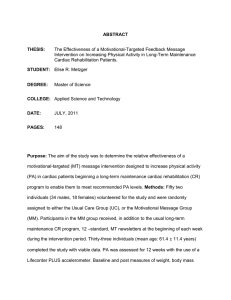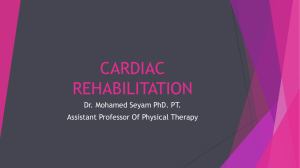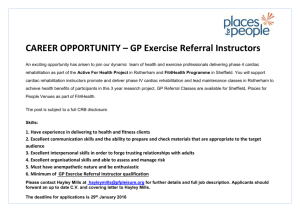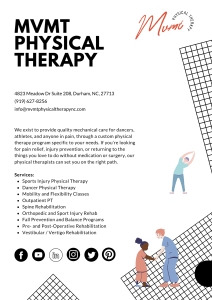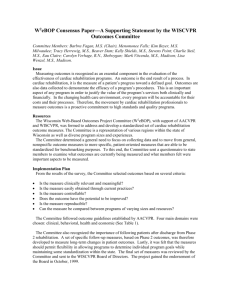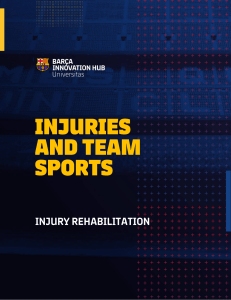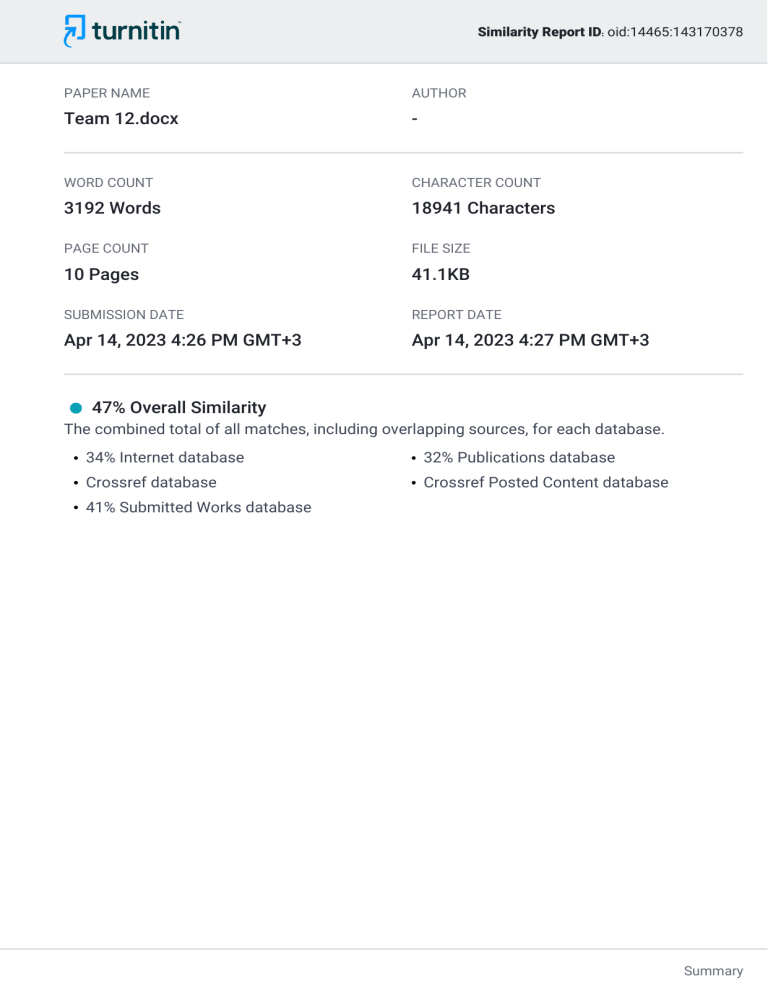
Similarity Report ID: oid:14465:143170378 PAPER NAME AUTHOR Team 12.docx - WORD COUNT CHARACTER COUNT 3192 Words 18941 Characters PAGE COUNT FILE SIZE 10 Pages 41.1KB SUBMISSION DATE REPORT DATE Apr 14, 2023 4:26 PM GMT+3 Apr 14, 2023 4:27 PM GMT+3 47% Overall Similarity The combined total of all matches, including overlapping sources, for each database. 34% Internet database 32% Publications database Crossref database Crossref Posted Content database 41% Submitted Works database Summary 12 1 HEALTH PSYCHOLOGY Year one - Semester two CV Team PROJECT TWO – literature Review 1500 words template CARDIAC REHABILITATION 1. Complete the form below (all fields must be filled). 2. The document name should be of the team number.doc (e.g., team 25.doc). Please also change the header to your team number 3. All text must be formatted as Arial, 12-point, black color and have single line spacing. Italic, bold and underline styles are optional. 4. Total word count 1500 words (excludes headings and questions, references, student information, instructions, search strategy, etc.). 5. Please refer to the detailed CV Project 2 guidelines for full details and instructions Project Title: Literature review for cardiac rehabilitation Team number: Team 12 Date of final submission: Team details Student ID number: Team role Number of meetings attended 0-6 who uploaded To Kaizen X Student 1 21200695 Coach 6 X Student 2 21200178 Director 6 Student 3 21200617 Connector 6 Student 4 22200354 Actualizer 6 Student 5 21200146 Finalizer 6 Student 6 21204160 Diplomat 6 Student 7 21202341 Judge appraiser 6 1 12 Literature Review Cardiac rehabilitation Importance and Efficacy of Remote Cardiac Rehabilitation: A Literature Review Ayah Alia, Kawthar Maqwara, Lulwa Alselahya, Nawaf Albassama, Qaswar Sudania, Saif Aly Kabania, Zayed Behzada a 2 MED Year 1, School of Medicine, Royal College of Surgeons Ireland - Medical University of Bahrain 51 1. Introduction 1.1. Cardiac Rehabilitation CR (cardiac rehabilitation) utilizes specific exercises supervised by health care professionals, such as cycling, swimming, running, and walking, which benefit the patient’s blood lipid levels and blood pressure. The goal is to help them return to an active lifestyle post coronary artery disease, myocardial infarction, and atherosclerosis.1 CR comprises three phases: Clinical, out-patient, and post-CR.2 The clinical phase focuses on post-intervention therapy and assessing the patient’s ability to tolerate rehabilitation. Out-patient CR focuses on developing a patient-centered therapy plan and starting physical rehabilitation to prevent recurrent events. Post-CR involves aerobic training and independence, where the patient can maintain a healthy, active lifestyle at home with intervention as necessary.3 CR has clear positive effects as it reduces heart disease mortality.4,5 It was also beneficial in preventing future heart problems in those with a risk factor that is a precursor to cardiovascular disease.6 1.2. Inequity in Access to Cardiac Rehabilitation 6 There are several barriers that prevent heart failure patients from accessing cardiac rehabilitation. These include a lack of awareness about the availability of rehab programs 47 and transportation issues for those who live in rural or remote areas. In addition, there are cost concerns due to insurance coverage limitations, time constraints for patients who work full-time, and physical limitations such as mobility issues.7 Additionally, social barriers such as profiling based on race, gender, and culture may also be factors that limit access to cardiac rehabilitation services.8 Addressing these 50 barriers is important because research has45 shown that participation in cardiac rehabilitation can improve outcomes such as quality of life, functional capacity, and mortality rates among people with heart failure. Nonetheless, a randomized program 57 concluded no correlation between CR and all-cause mortality.7 Howbeit,54a gender bias of mostly males led to a reduction in accuracy. It is important to note that there is a lack of data on the effects of CR on patient populations from populations due to attrition bias. 2 12 Attrition bias is the process by which the number of participants decreases for multiple reasons: unwanted side effects, dissatisfaction with treatments, or death from other causes. This bias further decreases the generalisability, validity, and reliability of the results.9 1.2.1. Racial Inequity 18 Even though rates of hypertension prevalence are highest in African Americans.10– 18 12 They are less likely to be appropriately treated for most of the conditions predisposed to the development of PAD, including cigarette smoking, diabetes, hypertension, and hyperlipidemia. Lack of referral and financial resources are among the main barriers to CR participation globally.13 However, most patients who need this rehabilitation are inpatients who are referred to the3 program by their attending doctor, thus minimizing the number of walk-in CR patients. Studies indicate that 3CR referral and participation rates are lower among patients from ethnic minorities. When socioeconomic status and education access are controlled, ethnic minorities often receive lower-quality health care 39 than white patients. It is unclear how the quality of health care was measured and it is difficult to know if ethnicity played a part in the wellbeing of the patients throughout the trials.14 1.2.2. Gender Women tend to have a lower referral and enrollment rate than men.15,16 They also have a higher dropout rate due to social and logistical factors (e.g., family responsibilities and dependence).16 One study conducted in 2017 with 44 men and 21 women aged 50 to 76 argues that women older than 65 are more prone to disabilities post-cardiac surgery.15,17 This once again launches a gender bias towards this study, and the sample size is too small compared to a study with 1,297,204 bypass surgeries, including 317,716 done in females. The latter study established, with and without prejudice, that female bypass patients had an increased risk of mortality between 28 to 41%. This plays a role in females not getting the opportunity to participate in cardiac rehabilitation programs.18 1.2.3. Age Due to the elderly community being more prone to suffer through a heart attack, stroke, and CAD, there is a lack of evidence attributed to selection bias on the effectiveness of CR in different age groups.19 Additionally, younger patients who do 39 experience cardiovascular diseases inevitably have a higher mortality rate making it difficult to determine the relationship between age and CR due to a phenomenon called survivorship bias.6 1.3. Comorbidities 3 12 Although comorbidities such as obesity are believed to affect the outcome of cardiac rehabilitation, a study conducted in 2021 suggests no significant negative correlation between heart health and measurable results. This includes chronotropic competence 53 after cardiac rehabilitation between obese and non-obese patients.20 1.4. Telehealth and Telerehabilitation Telehealth or mHealth21 is a system of providing healthcare remotely through 60 22,23 wireless technology. This includes video conferencing, remote monitoring, and 29 29 mobile apps. It allows patients to receive medical care from their homes, reducing the need for in-person visits and improving access to healthcare, especially for those who live in remote areas or have mobility issues. Telehealth has been increasingly used recently and has become especially relevant during the COVID-19 pandemic.24 Telerehabilitation is a type of telehealth that specifically focuses on providing rehabilitation services remotely through technology.25 It can include video conferencing sessions with a physical therapist or other healthcare providers, remote monitoring of exercises and progress, and using mobile apps to guide patients through their rehabilitation programs.26 49 Telerehabilitation has been shown to be effective for various conditions such as stroke, spinal cord injury, and musculoskeletal disorders. Like telehealth in general, it can improve access to care for those with difficulty traveling or accessing traditional inperson rehab services due to socio-economic barriers. However, there is not enough data to come to a conclusion on the efficacy of telerehabilitation and there were no details regarding the sample size and exclusion criteria.27 1.5. Availability and Timing of CR Programs 59 The British Heart Foundation recommends cardiac rehabilitation to commence within four weeks (28 days) of interventions.1 These interventions include PCI, and postMI-PCI; however, for coronary bypass surgery (CABG), the recommended commencement period is adjusted for recovery and is therefore increased to 42 days. A 23 paper from 2015 conducted a data analysis on the NHS National Audit of Cardiac Rehabilitation (NACR) database. The study noted a strong correlation and concluded that 44 for each day delayed in the commencement of CR; the patients were 1% less likely to improve 23in fitness-related measures. In reference to early rehabilitation, patients achieved healthy physical activity levels, and normal fitness-related QoL increased by 31% and 36%, respectively. On the contrary, late rehabilitation patients improved their 23 physical activity levels and QoL by 27% and 29%, respectively.28 More details should have been provided on the limitations and biases.These include lack of control, confounding variables and how the participants were selected. 1.6. Target audience of CR 4 12 CR programmes are designated for cardiovascular patients. However, it is worth noting that stroke patients and CAD patients share similar risk factors29,30 which is why it could benefit them to join the cardiac rehabilitation program.31,32 However, it is questionable whether or not they should be enrolled in the program as it produces many ethical issues in relation to their inclusion.33 One of these issues would be occupying the possibly available spaces for patients recovering from a heart attack. In addition, it is important to note that stroke and cardiac patients may have different needs to treat their specific concerns.31 Therefore, the best program for cardiac patients should include aerobic exercises.34 This also applies to stroke patients as they are likely to suffer from neurological deficits which can be most effectively treated with resistance exercises and physiotherapy. It is important to note that both groups can benefit from the reduction in risk factors, positive lifestyle changes and education but it may be unethical to combine their treatment as it leads to inadequate care for both groups.29 2. 3. Objectives 40 Highlight the current literature on the efficacy of hospital-based cardiac rehabilitation. 40 Explore barriers to access and adherence to cardiac rehabilitation. Ascertain the value of remote methods of cardiac rehabilitation in overcoming these barriers. Determine if CR can be expanded to include stroke patients. Summarise and critique studies investigating alternate methods of cardiac rehabilitation and their effectiveness. Methodology 3.1 Search Strategy The search was conducted across PubMed, MEDLINE, and PubMedCentral databases. Two MeSH terms were used in the search: ”Cardiac Rehabilitation” and ”Telerehabilitation”. Additionally, other similar keywords were added to the query. The query yielded 81 results. Their results were further narrowed by assessing them through our inclusion criteria. 3.2 Inclusion Criteria All studies included in this review were published between 2013-2023, measure quantitative data and have full text available. 5 12 4. Discussion 58 Currently, two forms of cardiac rehabilitation, center-based and home-based, are provided to patients. During center-based rehabilitation, patients are supervised, making it a safer option.35 However, it’s more costly as it runs over a longer course of time and could be unsuitable for people living in rural areas.36 Home-based CR is only ideal when the patients are compliant and disciplined enough to do everything independently. Center46 based cardiac rehabilitation had a higher drop-out rate than home-based cardiac 55 rehabilitation. Still, both programs positively affected clinical outcomes and quality of life.37 Home-based cardiac rehabilitation is more convenient but compromises on improvements in chronotropic measures.38,39,27 In regard to overcoming barriers in minority groups, efforts should be made to improve accessibility by offering home-based CR to patients struggling with constraints. Patients should be made aware of CR programs post-discharge to prevent overwhelming them with information. Furthermore, more equipment and staff should be allocated to CR programs to increase uptake and decrease waiting times and improve outcomes from timely interventions. General solutions to the barriers faced by CR patients would be improving the accessibility of the affiliated health care departments, making the programs more individualized rather than doing it in groups, and raising awareness on the importance of cardiac rehabilitation as an element of full recovery and treatment of certain heart conditions. 5. Conclusion In conclusion, the importance of3 cardiac rehabilitation is usually undermined by doctors and patients so it is necessary to assess the effectiveness of cardiac rehabilitation in the methods available of following through with it and how accessible it is when needed. It is also important to evaluate the different barriers that affect uptake, adherence, and prognosis of the treatment and draw solutions to such barriers. CR could branch out to other areas of detrimental diseases such as strokes which adds to the many motives of uptaking of such programs. Wordcount: 1603 not including methodology. 6 12 28 Not included in the word count REFERENCES (VANCOUVER STYLE) (this section is not included in the word count) 1. Cardiac rehabilitation: your questions answered [Internet]. [cited 2023 Apr 14]. Available 43 from: https://www.bhf.org.uk/informationsupport/heart-mattersmagazine/wellbeing/cardiac-rehab 30 2. Tessler J, Bordoni B. Cardiac Rehabilitation. In: StatPearls [Internet]. Treasure Island (FL): StatPearls Publishing; 2023 [cited 2023 Apr 11]. Available from: http://www.ncbi.nlm.nih.gov/books/NBK537196/ 48 3. MNG_D1_4. Rehabilitation guideline of Myocardial Infarction.pdf [Internet]. [cited 2023 38 Apr 14]. Available from: https://extranet.who.int/ncdccs/Data/MNG_D1_4.%20Rehabilitation%20guideline%20of %20Myocardial%20Infarction.pdf 14 4. Powell R, McGregor G, Ennis S, Kimani PK, Underwood M. Is exercise-based cardiac rehabilitation effective? A systematic review and meta-analysis to re-examine the evidence. BMJ Open. 2018 Mar 14;8(3):e019656. 15 5. Long L, Mordi IR, Bridges C, Sagar VA, Davies EJ, Coats AJ, et al. Exercise-based cardiac rehabilitation for adults with heart failure. Cochrane Database Syst Rev. 2019 Jan 29;1(1):CD003331. 25 6. Deley G, Culas C, Blonde MC, Mourey F, Vergès B. Physical and Psychological Effectiveness of Cardiac Rehabilitation: Age Is Not a Limiting Factor! Can J Cardiol. 2019 Oct;35(10):1353–8. 11 7. Ruano-Ravina A, Pena-Gil C, Abu-Assi E, Raposeiras S, van ’t Hof A, Meindersma E, et al. Participation and adherence to cardiac rehabilitation programs. A systematic review. Int J Cardiol. 2016 Nov 15;223:436–43. 2 8. Mead H, Ramos C, Grantham SC. Drivers of Racial and Ethnic Disparities in Cardiac Rehabilitation Use: Patient and Provider Perspectives. Med Care Res Rev. 2016 Jun;73(3):251–82. 27 9. Brueton V, Tierney J, Stenning S, Nazareth I, Meredith S, Harding S, et al. Strategies to reduce36attrition in randomised trials. Trials. 2011 Dec;12(S1):A128. 10. Gregory PC, LaVeist TA, Simpson C. Racial disparities in access to cardiac rehabilitation. Am J Phys Med Rehabil. 2006 Sep;85(9):705–10. 41 11. Musemwa N, Gadegbeku CA. Hypertension in African Americans. Curr Cardiol Rep. 2017 Dec;19(12):129. 33 12. Lackland DT. Racial Differences in Hypertension: Implications for High Blood Pressure Management. Am J Med Sci. 2014 Aug;348(2):135–8. 31 13. Vanzella LM, Oh P, Pakosh M, Ghisi GLM. Barriers to Cardiac Rehabilitation in Ethnic Minority Groups: A Scoping Review. J Immigr Minor Health. 2021 Aug;23(4):824–39. 1 14. Mathews L, Akhiwu O, Mukherjee M, Blumenthal RS, Matsushita K, Ndumele CE. Disparities in the Use of Cardiac Rehabilitation in African Americans. Curr Cardiovasc Risk Rep. 2022;16(5):31–41. 7 12 15. 16 Socha M, Wronecki K, Sobiech KA. Gender and age-dependent differences in body composition changes in response to cardiac rehabilitation exercise training in patients after coronary artery bypass grafting. Ann Agric Environ Med AAEM. 2017 Sep 21;24(3):517–21. 3 16. Bittner V. Cardiac Rehabilitation for Women. Adv Exp Med Biol. 2018;1065:565– 77. 34 17. Sawan MA, Calhoun AE, Fatade YA, Wenger NK. Cardiac rehabilitation in women, challenges and opportunities. Prog Cardiovasc Dis. 2022;70:111–8. 42 18. 37 Gaudino M, Chadow D, Rahouma M, Soletti GJ, Sandner S, Perezgrovas-Olaria R, et al. Operative Outcomes of Women Undergoing Coronary Artery Bypass52Surgery in 56 the US, 2011 to 2020. JAMA Surg [Internet]. 2023 Mar 1 [cited 2023 Apr 11]; Available from: https://jamanetwork.com/journals/jamasurgery/fullarticle/2802105 32 19. Heart Health and Aging [Internet]. National Institute on Aging. [cited 2023 Apr 11]. Available from: https://www.nia.nih.gov/health/heart-health-and-aging 6 20. El Missiri A, Abdel Halim WA, Almaweri AS, Mohamed TR. Effect of a phase 2 cardiac rehabilitation program on obese and non-obese patients with stable coronary artery 24disease. Egypt Heart J. 2021 Jan 7;73:4. 21. Istepanian R, Jovanov E, Zhang YT. Introduction to the special section on MHealth: beyond seamless mobility and global wireless health-care connectivity. IEEE Trans Inf Technol 35Biomed Publ IEEE Eng Med Biol Soc. 2004 Dec;8(4):405–14. 22. Telehealth [Internet]. National Institute of Biomedical Imaging and Bioengineering. [cited 2023 Apr 11]. Available from: https://www.nibib.nih.gov/scienceeducation/science-topics/telehealth 4 23. Sari DM, Wijaya LCG. Cardiac rehabilitation via telerehabilitation in COVID-19 pandemic situation. Egypt Heart J. 2021 Mar 29;73(1):31. 5 24. Ramachandran HJ, Jiang Y, Tam WWS, Yeo TJ, Wang W. Effectiveness of home-based cardiac telerehabilitation as an alternative to Phase 2 cardiac rehabilitation of coronary heart disease: a systematic review and meta-analysis. Eur J Prev Cardiol. 2021 Jul 13;zwab106. 17 25. Peretti A, Amenta F, Tayebati SK, Nittari G, Mahdi SS. Telerehabilitation: Review of the State-of-the-Art and Areas of Application. JMIR Rehabil Assist Technol. 2017 Jul 21;4(2):e7. 10 26. Nkonde-Price C, Reynolds K, Najem M, Yang SJ, Batiste C, Cotter T, et al. Comparison of Home-Based vs Center-Based Cardiac Rehabilitation in Hospitalization, Medication Adherence, and Risk Factor Control Among Patients With Cardiovascular Disease. JAMA Netw Open. 2022 Aug 1;5(8):e2228720. 19 27. Clark RA, Conway A, Poulsen V, Keech W, Tirimacco R, Tideman P. Alternative models of cardiac rehabilitation: A systematic review. Eur J Prev Cardiol. 2015 Jan 1;22(1):35–74. 26 28. Fell J, Dale V, Doherty P. Does the timing of cardiac rehabilitation impact fitness outcomes? An observational analysis. Open Heart. 2016 Aug 1;3(1):e000369. 12 29. Jeffares I, Merriman NA, Doyle F, Horgan F, Hickey A. Inclusion of stroke patients in expanded cardiac rehabilitation services: a cross-national qualitative study with cardiac and stroke rehabilitation professionals. Disabil Rehabil. 2022 Jul;44(14):3610–22. 8 12 30. 8 Candelaria D, Kirkness A, Farrell M, Roach K, Gooley L, Fletcher A, et al. Remote-delivered cardiac rehabilitation during COVID-19: a prospective cohort comparison of health-related quality of life outcomes and patient experiences. Eur J Cardiovasc Nurs. 2022 Feb 8;zvac006. 9 31. Marzolini S. Integrating Individuals With Stroke Into Cardiac Rehabilitation Following Traditional Stroke Rehabilitation: Promoting a Continuum of Care. Can J Cardiol. 2018 Oct;34(10 Suppl 2):S240–6. 9 32. Stone JE, Dukelow S, Stone JA. Stroke Rehabilitation and Cardiac Rehabilitation: Siblings or Strangers? CJC Open. 2020 May 23;2(4):189–91. 22 33. Rannikko S, Stolt M, Suhonen R, Leino-Kilpi H. Ethical issues in the care of patients with stroke: A scoping review. J Clin Nurs. 2019;28(1–2):20–31. 1 34. Toma J, Hammond B, Chan V, Peacocke A, Salehi B, Jhingan P, et al. Inclusion of People Poststroke in Cardiac Rehabilitation Programs in Canada: A Missed Opportunity for Referral. CJC Open. 2020 Feb 10;2(4):195–206. 13 35. Hwang R, Bruning J, Morris NR, Mandrusiak A, Russell T. Home-based telerehabilitation is not inferior to a centre-based program in patients with chronic heart failure:2 a randomised trial. J Physiother. 2017 Apr;63(2):101–7. 36. Kraal JJ, Van den Akker-Van Marle ME, Abu-Hanna A, Stut W, Peek N, Kemps HM. Clinical and cost-effectiveness of home-based cardiac rehabilitation compared to conventional, centre-based cardiac rehabilitation: Results of the FIT@Home study. Eur J Prev4Cardiol. 2017 Aug;24(12):1260–73. 37. Dalal HM, Doherty P, McDonagh ST, Paul K, Taylor RS. Virtual and in-person cardiac rehabilitation. The BMJ. 2021 Jun 3;373:n1270. 20 38. Anderson L, Sharp GA, Norton RJ, Dalal H, Dean SG, Jolly K, et al. Home‐based versus centre‐based cardiac rehabilitation. Cochrane Database Syst Rev. 2017 Jun 30;2017(6):CD007130. 21 39. Bashshur R, Doarn CR, Frenk JM, Kvedar JC, Woolliscroft JO. Telemedicine and the COVID-19 Pandemic, Lessons for the Future. Telemed J E-Health Off J Am Telemed Assoc. 2020 May;26(5):571–3. 9 12 7 REFER TO THE LIBRARY TUTORIAL FOR INSTRUCTIONS ON HOW TO COMPLETE THIS TABLE This section is not included in the word count expand as required Sources Terms used, Hits How articles were finally searched, combinations chosen dates 3,689 PubMed, "Cardiac Depending on relevance of March 25 Rehabilitation"[Mesh] studies and facts such as definitions PubMed, "Telerehabilitation"[Mesh] 936 Depending on relevance March 25 towards patients and outcomes PubMed, ("Cardiac 40 Relevant to advantages and March 27 Rehabilitation"[Mesh]) disadvantages of stroke AND "Stroke"[Mesh] patients in CR Medline, Cardiac rehabilitation 131 How up to date and what April 2nd effective groups were chosen to determine effectiveness Medline, Cardiac rehabilitation 398 Relevant to cardiac April 2nd types rehabilitation phases and categories PubMed, Telerehabilitation 233 Up to date April 5th PubMed, Cardiac rehabilitation 113 Relevant and contains April 10 target evidence PubMed, Inequalities in Cardiac 8 Evidence based and relevant April 10 rehabilitation to patient 10 Similarity Report ID: oid:14465:143170378 47% Overall Similarity Top sources found in the following databases: 34% Internet database 32% Publications database Crossref database Crossref Posted Content database 41% Submitted Works database TOP SOURCES The sources with the highest number of matches within the submission. Overlapping sources will not be displayed. 1 2 3 4 5 6 7 8 Royal College of Surgeons in Ireland on 2023-04-13 Submitted works ncbi.nlm.nih.gov Internet researchgate.net Internet globalcardiacrehab.com Internet static.cigna.com Internet wjgnet.com Internet Royal College of Surgeons in Ireland on 2023-04-13 Submitted works University of Sydney on 2022-05-24 Submitted works 6% 3% 2% 1% 1% 1% 1% 1% Sources overview Similarity Report ID: oid:14465:143170378 9 10 11 12 13 14 15 16 17 18 19 20 e-bnr.org 1% Internet University of Northumbria at Newcastle on 2023-01-13 1% Submitted works dukespace.lib.duke.edu 1% Internet Royal College of Surgeons in Ireland on 2023-04-13 1% Submitted works jmir.org 1% Internet Middlesex University on 2022-09-04 <1% Submitted works Kartik Deshmukh, Arjun Khanna. "Implications of managing Chronic Ob... Crossref repository.uantwerpen.be <1% Internet rehab.jmir.org <1% Internet Eddie L. Hackler, Naomi M. Hamburg, Khendi T. White Solaru. "Racial a... Crossref clinfowiki.org Internet Queensland University of Technology on 2020-03-12 Submitted works <1% <1% <1% <1% Sources overview Similarity Report ID: oid:14465:143170378 21 22 23 24 25 26 27 28 29 30 31 32 Sarah M Kling, Matthew M Philp. "The effects of the COVID-19 pandem... Crossref lsmuni.lt Internet eprints.whiterose.ac.uk Internet bmccardiovascdisord.biomedcentral.com Internet dspace.uef.fi Internet Royal College of Surgeons in Ireland on 2023-04-12 Submitted works University of Liverpool on 2023-04-10 Submitted works Royal College of Surgeons in Ireland on 2023-04-13 Submitted works Colorado Technical University on 2023-01-19 Submitted works Eric Coffman on 2022-04-18 Submitted works ses.library.usyd.edu.au Internet Royal College of Surgeons in Ireland on 2023-03-02 Submitted works <1% <1% <1% <1% <1% <1% <1% <1% <1% <1% <1% <1% Sources overview Similarity Report ID: oid:14465:143170378 33 34 35 36 37 38 39 40 41 42 43 44 en.wikipedia.org Internet srpskiarhiv.rs Internet University of Exeter on 2022-12-12 Submitted works link.springer.com Internet nhi.no Internet University of Hertfordshire on 2021-01-03 Submitted works Liberty University on 2023-03-10 Submitted works University of Nottingham on 2018-09-07 Submitted works researchsquare.com Internet University of Edinburgh on 2023-03-17 Submitted works Royal College of Surgeons in Ireland on 2023-04-14 Submitted works essay.utwente.nl Internet <1% <1% <1% <1% <1% <1% <1% <1% <1% <1% <1% <1% Sources overview Similarity Report ID: oid:14465:143170378 45 46 47 48 49 50 51 52 53 54 55 56 University of Edinburgh on 2022-08-18 Submitted works University of Lancaster on 2021-01-11 Submitted works Montana State University, Billings on 2018-11-16 Submitted works Singapore Institute of Technology on 2022-02-21 Submitted works mhealth.jmir.org Internet South Bank University on 2022-10-07 Submitted works University of Aberdeen on 2021-04-01 Submitted works University of Brighton on 2023-04-03 Submitted works University of Glamorgan on 2017-04-24 Submitted works library.unisel.edu.my Internet research-repository.griffith.edu.au Internet cjess.ca Internet <1% <1% <1% <1% <1% <1% <1% <1% <1% <1% <1% <1% Sources overview Similarity Report ID: oid:14465:143170378 57 58 59 60 Cardiff University on 2021-11-29 <1% Submitted works H. M Dalal, A. Zawada, K. Jolly, T. Moxham, R. S Taylor. "Home based v... Crossref Sebastian Hinde, Alexander Harrison, Laura Bojke, Patrick Doherty. "Qu... Crossref University of Salford on 2023-03-23 Submitted works <1% <1% <1% Sources overview
